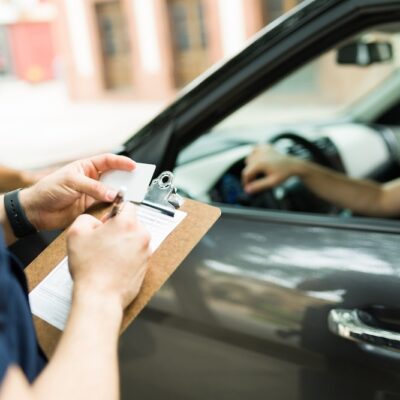At around 7AM this morning, a multi-vehicle car accident on the Sydney Harbour Bridge caused significant traffic delays, with all lanes on the Bridge closed for several hours after the accident.
Dashcam footage of the incident captures a black SUV driving at a high speed, merging between lanes only to swerve directly into oncoming traffic and collide with a van and other vehicles. As a result of the collision, the black SUV rotates onto its roof before bursting into flames.
Three other vehicles were involved in the collision. The driver of the van required the assistance of emergency services to be removed from his vehicle, and was later taken to hospital in a serious condition. The two drivers of the other vehicles also required medical attention, and have also been taken to hospital with non-life-threatening injuries.
So, what criminal offences could the driver of the black SUV be criminally liable for? Let’s analyse the applicable law in NSW and apply it to the limited information at hand…
Dangerous driving occasioning grievous bodily harm
Under s 52A(3) of the Crimes Act (NSW) 1900, a person is guilty of this offence if:
- The vehicle driven by the person is involved in an impact occasioning grievous bodily harm to another person; and
- The driver was, at the time of the impact, driving the vehicle –
- under the influence of intoxicating liquor or of a drug, or
- at a speed dangerous to another person or persons, or
- in a manner dangerous to another person or persons.
A person convicted of this offence may be liable to imprisonment for a maximum of 7 years.
‘Grievous bodily harm’ includes any permanent of serious disfiguring of a person. An aggravated version of this offence attracts an increased maximum term of imprisonment of 11 years.
The black SUV is depicted in the video swerving of the SUV at a fast speed into oncoming traffic in another lane. This would more than likely establish that the vehicle was driving in a dangerous manner and at a dangerous speed.
The main issue here however, is whether the injuries suffered by any of the three drivers involved in the collision amount to ‘grievous bodily harm’. It has been reported that the driver of the van has suffered pelvic and leg injuries, currently in a serious but stable condition at hospital. Injuries for the other two drivers have been reported as ‘non-life-threatening’, therefore unlikely to amount to ‘grievous bodily harm’.
For the driver of the van however, if the injuries to his legs or pelvis are so serious that he never regains full and normal function, thereby causing permanent harm with lifelong implications, this would constitute ‘grievous bodily harm’. The driver of the vehicle could then be charged with this offence of ‘dangerous driving occasioning grievous bodily harm’ with respect to the harm caused to the driver of the van.
He could also however potentially be charged with ‘furious driving’ offences for the harm caused to the other two drivers.
Furious Driving
When less serious injuries result from a crash caused by dangerous driving, a person may instead be criminally liable for ‘furious driving’ under s 53 of the Crimes Act (NSW) 1900. A person could also still be charged with ‘negligent, furious or reckless driving’ under s 117(2) of the Road Transport Act 2013, even if their dangerous driving causes no harm at all.
A person is guilty of the offence of ‘furious driving’ under S 53 of the Crimes Act (NSW) 1900 if:
- They ‘furiously drive’ a vehicle, that is, at a manner, pace or speed which causes danger to the life or person of other users of the road[1]; and
- Such driving causes bodily harm to any person.
A person convicted of this offence may be liable to imprisonment for a maximum of 2 years.
Alternatively, a person is guilty of the offence of ‘furious driving’ under s 117(2) of the Road Transport Act 2013 if they drive a motor vehicle on a road furiously, recklessly or at a speed or in a manner dangerous to the public.
A person convicted of this offence may be liable to imprisonment for a maximum of 9 months and/or fined $2,200. If they have previously been convicted of this same offence, they may instead be liable to imprisonment for a maximum of 12 months and/or fined $3,300.
Both ‘furious driving’ offences also attract a minimum 12 month licence disqualification. If however the driver also has a previous ‘furious driving’ conviction, their licence will be disqualified for a minimum of 2 years.
As the other two drivers involved in the collision have suffered injuries (although non-life-threatening), and therefore ‘bodily harm’, the driver of the black SUV could also be charged with ‘furious driving’ under the Crimes Act (NSW) 1900.
So there you have it – a brief legal analysis of today’s Harbour Bridge car collision and discussion of the legal application of current traffic and criminal laws relating to dangerous or furious driving.
If you or anyone you know has been charged with this type of offence, you should immediately seek Legal Advice. Our experienced Criminal Defence Lawyers at KPT Defence Lawyers have significant and specialised experience in all areas of criminal and traffic law.
*Disclaimer: This is intended as general information only and not to be construed as legal advice. The above information is subject to changes over time. You should always seek professional advice before taking any course of action.*
[1] Askin Aslan v R [2015] NSWDC 185 at [39], Chatterton v Parker (1914) 3LT 381

















